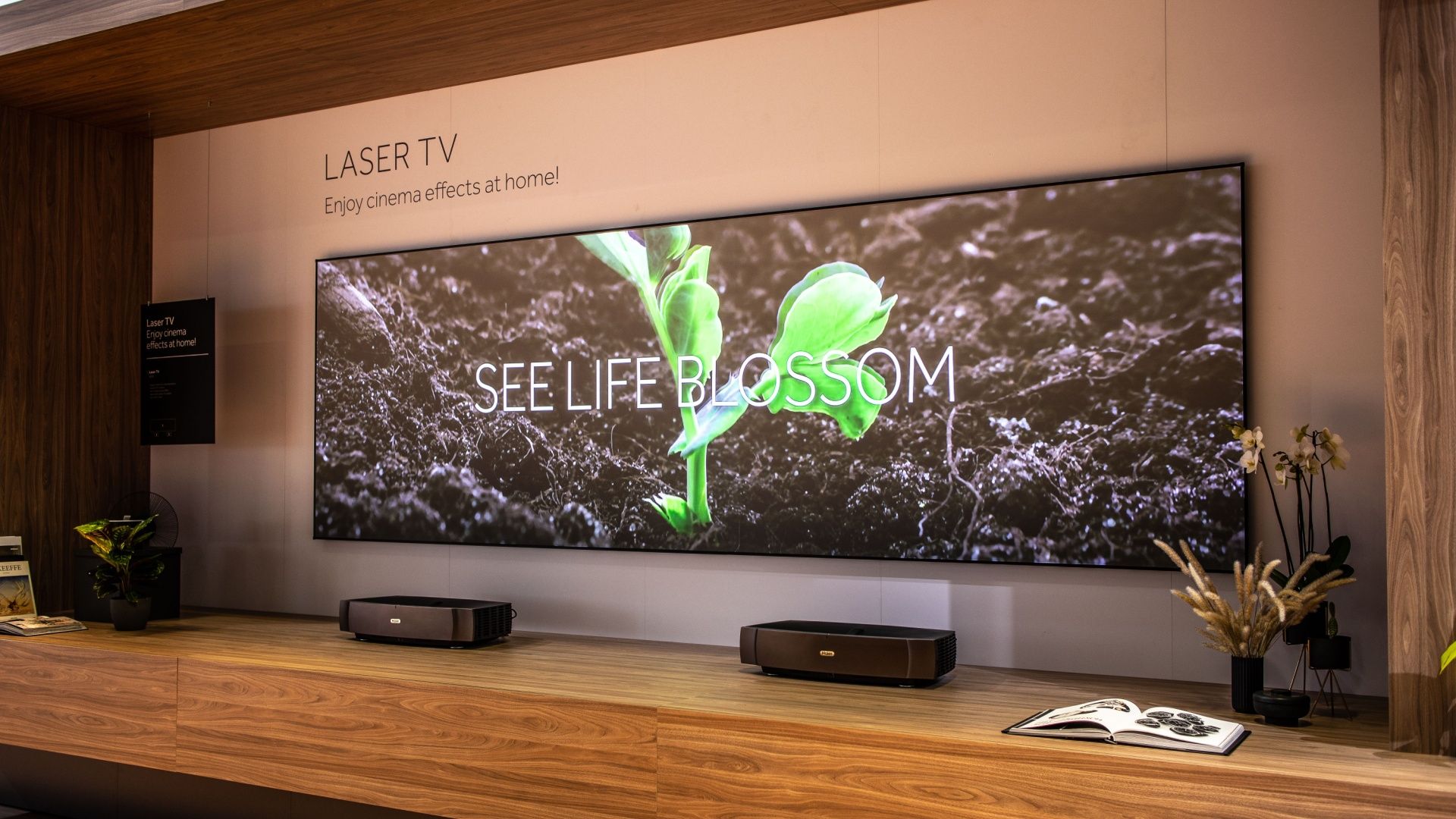**What Is a Laser TV?**
Those crafty marketers are always thinking of ways to make existing technology appeal to people in new ways. That’s why you may have seen advertising for “laser TVs,” which admittedly sound very sci-fi and futuristic. But, just what is a laser TV?
As it turns out, laser TVs aren’t actually TVs at all.
—
### What a Laser TV Actually Is
In short, a laser TV is a type of ultra-short throw (UST) projector. These projectors are designed to create a large projection image while sitting right up against the wall or other projection surface, unlike traditional “long throw” projectors.
The “laser” part of the name comes from the laser technology used to create light, instead of traditional bulbs or LEDs. Laser projectors can produce much brighter images, bringing them closer in brightness and quality to LCD TVs.
Marketers call these “TVs” because this type of projector is functionally similar to a traditional television. It sits upfront next to a wall, operates like a TV, turns on whenever you need it, and serves a similar purpose. Additionally, the lifespan of laser projectors is comparable to existing flat-panel TVs, so you can swap out your current TV for a laser TV as a drop-in replacement.
—
### How They Differ From Real Televisions
Laser TVs aren’t exactly like normal TVs. A real television has a built-in display panel, whether LCD, OLED, or MiniLED. A laser TV, on the other hand, requires a surface to project onto.
To get image quality close to that of a traditional TV, you’ll need to pair a laser TV with an ALR (Ambient Light Rejection) projection screen. Alternatively, you can paint your wall with special projector paint, though it won’t perform quite as well as an ALR screen.
So unlike a TV, a laser TV is not a self-contained display device—you need a projection surface to complete the setup.
—
### The Illusion of a TV-Like Experience
Laser TVs are designed to look and feel like TVs. They’re often sold with a matching projection screen, built-in tuners, or smart TV operating systems.
Instead of ceiling mounts and complicated setups, you simply place the unit on a cabinet, plug it in, and you get a 100-inch image on your wall.
Including an ALR screen with laser TVs is a common and smart practice because it removes potential hidden costs and means you can have your TV up and running straight out of the box. Mounting the screen is usually no more difficult than wall-mounting a traditional TV.
However, no matter how much it feels like a normal TV experience, you are still dealing with projection technology—and most of the usual projector pros and cons still apply.
—
### The Pros of Laser TVs
The benefits of laser TVs largely mirror those of any UST projector:
– **Large Image Sizes**: You can enjoy screen sizes that would be much more expensive if bought as a flat-panel TV.
– **Long Lifespan**: Laser TVs last almost as long as traditional TVs, and much longer than older projector types.
– **Compact & Unobtrusive**: They are more portable and less visually intrusive than standard TVs.
– **Flexible Setup**: Easy to move or relocate, and with the right setup, the projection screen can be hidden when not in use.
—
### Limitations Compared to Actual TVs
While laser projector technology has come a long way and is close to matching regular TVs in picture quality and performance, it still doesn’t quite measure up—especially compared to mid- and high-end TVs.
– **Brightness**: This can be a sticking point, especially in rooms with more ambient light, even when using an ALR screen.
– **Viewing Angles**: Not as good as those on mini-LED, OLED, or quality modern LCD TVs.
– **Setup & Maintenance**: Requires a bit more effort than just plugging in a traditional TV. It’s not quite as plug-and-play as the marketing would have you believe.
—
### But, The Name Causes Confusion
There’s absolutely nothing wrong with laser TVs as a product. They’re an excellent alternative to expensive large-format TVs, and projector technology is mature enough to serve as a practical TV replacement.
However, the name “laser TV” can cause confusion. It creates the impression that these devices are a one-to-one replacement for traditional TVs, which isn’t entirely accurate.
While the branding makes sense from a marketing perspective—it’s easier to sell a “Laser TV” than to explain the appeal of a UST projector—it can leave consumers with mismatched expectations.
—
**In Conclusion**
Laser TVs offer a compelling option for those seeking large-screen viewing without the high price tag of giant flat-panel TVs. Just keep in mind the differences and requirements before making the switch, so you get the best experience possible.
https://www.howtogeek.com/why-laser-tvs-arent-actually-tvs/
